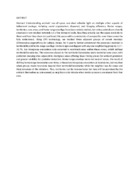5. Absentee owners and overlapping home ranges in a territorial species

View/
Date
2021-01-07Author
Isbell, Lynne A.
Bidner, Laura R.
Loftus, Carter
Kimuyu, Duncan M.
Young, Truman P.
Metadata
Show full item recordAbstract
Abstract Understanding animals’ use of space can shed valuable light on multiple other aspects of behavioral ecology, including social organization, dispersal, and foraging efficiency. Home ranges, territories, core areas, and home range overlaps have been widely studied, but unless animals are directly observed or are tracked remotely on a fine temporal scale, how they actually use the space available to them and how they share (or partition) this space with a community of conspecifics over time cannot be fully understood. Using GPS technology, we tracked three adjacent groups of vervet monkeys (Chlorocebus pygerythrus) in Laikipia, Kenya, for 1 year to better understand the processes involved in territoriality and home range overlaps. Home ranges overlapped with any one neighboring group by 12.7–34.7%, but intergroup encounters only occurred in restricted areas within these zones, which defined territorial boundaries. The resources closest to the territorial boundaries were nocturnal core areas with preferred sleeping sites adjacent to shortgrass areas offering fewer hiding places for ambush predators and greater visibility for predator detection. Home range overlaps were not neutral zones, the result of shifting home range boundaries over time, or based on intergroup encounters at boundaries, but resulted when groups made incursions beyond their territorial boundaries while the neighbor was far away and likely unaware of the intruders. Thus, territories can be non-exclusive but may still be perceived by the animals themselves as sole-owned, as neighbors only intrude when territory owners are absent from that area.